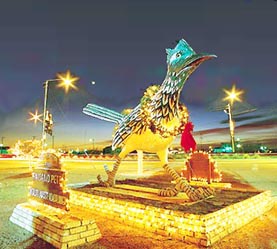General-
Town developed with the
establishment of a military post in 1859, an outpost on
Butterfield Overland Mail Route at crossing of Old San
Antonio Road and ancient Comanche War Trail. Popular with
Indians long before white men arrived because of large
springs nearby.
This area was one of the earliest irrigated farming
efforts in Texas; An estimated
8,000 acres were irrigated as early as 1877. Today, Fort
Stockton is the seat of Pecos County, retail and shipping
headquarters for vast ranching, natural gas and oil
activities, and a major West Texas crossroads. Hunting
excellent for mule deer and pronghorn antelope.
Annie Riggs Hotel Museum-
The old hotel, built 1899,
was a popular stop on stage route. Restored and
maintained by local historical society, features
area-related displays of life at turn of century. Open
daily Mon. - Sat. 10 - noon; 1 - 5 p.m.; Sun. 1:30 - 5
p.m.; summer till 8 p.m. daily. 301 S. Main St.
Comanche Springs-
Once among the largest
springs in Texas, now the site of an Olympic sized
swimming pool. Historical notations date from days of
Cabeza de Vaca's explorations, 1534, and other explorers
such as Espejo in 1583, Mendosa in 1684.
Courthouse Square-
Historic features include
courthouse (1883), first Catholic Church (1875), first
schoolhouse (1883), and Zero Stone placed by survey party
in 1859, used as origin point for all land surveys
in this part of West Texas. Nearby 8-t. Stephens
Episcopal Church (1872), was first Protestant Church west
of the Pecos River
Grey Mule Saloon -
Preserving nostalgic remembrance of
times past, restored old saloon was one of early-day
'red-eye" dispensaries of West Texas. Callaghan and
Main St.
Historical Sites Tour -
A series of special signs on city
streets provide guidance for do-it-yourself tour of
historic sites. Friendly citizens will fill in details.
James Rooney County Park-
Green and spacious park located on
the southern edge of city at the historic Comanche
Springs. Swimming, picnicing, and tennis courts.
Lake-
Imperial Reservoir.
Old Fort Cemetery -
Records on existing tombstones
indicate few people lived beyond age 40; indication of
hardships among those who opened and settled this harsh
country.
Old Fort Stockton-
Typical frontier military post
established in 1859, and abandoned in 1886. Many original
buildings of adobe ard hand hewn limestone still stand.
Officers' Row and old guardhouse on Williams St.
between 4th and bib St.
Paisano Pete -

At 20 feet long and
11 feet tall, Pete is probably the world's largest
roadrunner!
A very popular
photo subject.
Located on U.S. 290
at Main St.
Paisano Pete's holiday garb gives travelers in Fort Stockton one more reason to pause for a photo moment at this roadside monument honoring the roadrunner.
Tunis Creek Stagecoach Stop -
Former way station on Butterfield
Overland Mail Route; later a Texas Ranger station His
toric structure was moved to a highway rest area on U.S. 290
20 miles east. Original location was approximately
two miles south.
Visit the City of Fort Stockton Home Page
for more information!
|


